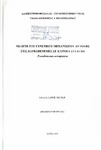Μελέτη του γενετικού μηχανισμού αντοχής στις καρβαπενέμες σε κλινικά στελέχη Pseudomonas aeruginosa

Προβολή/
Συγγραφέας
Σακελλάρης, ΒίκτωρΌνομα Επιβλέποντος
Μόσιαλος, Δημήτρης
Ημερομηνία
2010Γλώσσα
el
Πρόσβαση
ελεύθερη
Επιτομή
Pseudomonas aeruginosa is one of the most common gram-negative hospitalacquired
pathogens. This organism shows a remarkable resistance to antibiotics, mostly
because of acquisition of resistance genes e.g., genes for beta-lactamases, combined with
over-expression of efflux pumps and/or decreased expression of porins. The most
common beta-lactamases are IMP and VIM type MBL, as well as OXA-ESBLS and give
to the bacteria high resistance to b-lactam antibiotics, especially carbapenems. The genes
for VIM and IMP enzymes, like those for OXA-ESBLs, are transferable as most are
found as gene cassettes located primarily on integrons, sometimes within transposons or
on plasmids, a condition that provides a wide potential for expression and dissemination
in gram-negative pathogens. Since the first finding of IMP] metallo-B-lactamase in a
clinical isolate of Pseudomonas aeruginosa in Japan in 1988, IMP-type enzymes are
spread worldwide, increasing in two decades the proportion of P. aeruginosa isolates
demonstrating resistance to imipenem, due to IMPmbls? from 13% to 20%. Currently have
indentified 26 carbapenem-hydrolyzing enzymes of the IMP-type.
In this study we present the discovery of a new IMP type MBL from 6 P.
aeruginosa clinical strains. This novel IMP-type MBL is highly divergent from IMPi,
possessing 44 different amino acids, whereas the most divergent till now IMP-type MBL,
IMP12, has only 36 different amino acids from IMP]. This new IMP-MBLs was found in
a class 1 integron next to ΟΧʼ35 gene. The next objective will be the biochemical
characterization of this new IMP metallo-fl-lactamase.
Ακαδημαϊκός Εκδότης
Πανεπιστήμιο Θεσσαλίας. Σχολή Επιστημών Υγείας. Τμήμα Βιοχημείας και Βιοτεχνολογίας.


